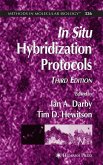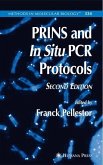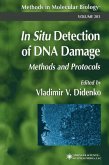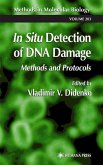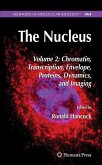The technique of in situ hybridization, in its various forms, has been used routinely in many laboratories for a number of years. In the post-genome era, gene arrays and proteomics have allowed us to identify hitherto unknown unrecognized pathways and mechanisms. However, rather than diminish the importance of in situ hybridization, the now widespread use of screening te- nologies has increased the need to temporally and spatially localize the dist- bution of mRNA expression. Our intention, in In Situ Hybridization Protocols is to provide ample inf- mation for novices planning to set up the in situ hybridization technique and use it in their laboratory for the first time, as well as giving updates of recent developments for those laboratories where in situ hybridization techniques are already in use. Despite its widespread significance, in situ hybridization has retained a re- tation as one of the more difficult and capricious molecular biological te- niques. This may in part be because of the hybrid nature of the technique, which often requires a mixture of molecular biological and histological skills. The two techniques are usually taught and acquired in different streams of biolo- cal science. The step-by-step and detailed protocols provided in In Situ Hybridization Protocols by researchers active in the field should make it p- sible for both the molecular biologist with little experience of histology and the histologist with little experience of molecular biology to use the technique s- cessfully in their laboratories.
Reviews of Previous Editions:
"...an indispensable laboratory manual for the current techniques used...essential for the current techniques used...essential for any laboratory that is using, or wants to use, the...technique in their repertoire."-Molecular Biotechnology
" . . .a good book for anyone wishing to exploit all that in situ hybridization has to offer."
-- Biopharm Manufacturing
Reviews for Second Edition...
"This book should be of interest to anyone using or considering in situ hybridization, as it provides well written, if rather specialized, examples of the many applications of this extremely useful but notoriously tricky technique...The text is well referenced and includes useful details of reagent suppliers as well as links to further information available over the internet. This is a book that aims to make in situ hybridization accessible to all, and to inspire new applications for the technique. In my opinion, it does a reasonably sound job of both."-Heredity
From Reviews of the Second Edition...
"...highly recommended for those researchers who use in situ hybridization in their work or for those who want to exploit for the first time the possibilities that this technique offers biomedical research" -European Urology Today
"...should be available in every major biomedical library as it represents the approach that morphological scientists can use to determine gene expression under different physiological and disease conditions in mature and developing tissues." -Journal of Anatomy
From the reviews of the third edition:
"In situ hybridization is already 25 years known method, which allows to detect specific RNA and DNA sequences at the cellular level within tissue sections. The third edition of this book focuses on tissue and cell in situ hybridization. ... The book is written with a broad readership in mind. It provides information for all researchers to set up this technique inthe laboratory, as well as to update the recent protocols, which are already in use." (H. Plchová, Biologia Plantarum, Vol. 50 (4), 2006)
"Darby and Hewitson have extensively changed the content and in doing so have made the book much more relevant and useful to the veterinary pathologist. The new third edition focuses on hybridization of cells and tissues, instead of having a major focus on chromosomes as in the previous edition. ... reading the book cover-to-cover allows one to gain a collective appreciation for various alternatives in methodology as well as interesting innovative procedural details." (Dr. R. A. Westhouse, Veterinary Pathology, Vol. 43 (4), 2006)
"...an indispensable laboratory manual for the current techniques used...essential for the current techniques used...essential for any laboratory that is using, or wants to use, the...technique in their repertoire."-Molecular Biotechnology
" . . .a good book for anyone wishing to exploit all that in situ hybridization has to offer."
-- Biopharm Manufacturing
Reviews for Second Edition...
"This book should be of interest to anyone using or considering in situ hybridization, as it provides well written, if rather specialized, examples of the many applications of this extremely useful but notoriously tricky technique...The text is well referenced and includes useful details of reagent suppliers as well as links to further information available over the internet. This is a book that aims to make in situ hybridization accessible to all, and to inspire new applications for the technique. In my opinion, it does a reasonably sound job of both."-Heredity
From Reviews of the Second Edition...
"...highly recommended for those researchers who use in situ hybridization in their work or for those who want to exploit for the first time the possibilities that this technique offers biomedical research" -European Urology Today
"...should be available in every major biomedical library as it represents the approach that morphological scientists can use to determine gene expression under different physiological and disease conditions in mature and developing tissues." -Journal of Anatomy
From the reviews of the third edition:
"In situ hybridization is already 25 years known method, which allows to detect specific RNA and DNA sequences at the cellular level within tissue sections. The third edition of this book focuses on tissue and cell in situ hybridization. ... The book is written with a broad readership in mind. It provides information for all researchers to set up this technique inthe laboratory, as well as to update the recent protocols, which are already in use." (H. Plchová, Biologia Plantarum, Vol. 50 (4), 2006)
"Darby and Hewitson have extensively changed the content and in doing so have made the book much more relevant and useful to the veterinary pathologist. The new third edition focuses on hybridization of cells and tissues, instead of having a major focus on chromosomes as in the previous edition. ... reading the book cover-to-cover allows one to gain a collective appreciation for various alternatives in methodology as well as interesting innovative procedural details." (Dr. R. A. Westhouse, Veterinary Pathology, Vol. 43 (4), 2006)


